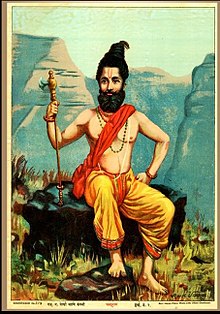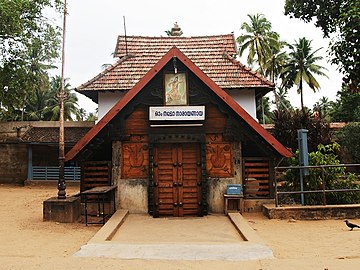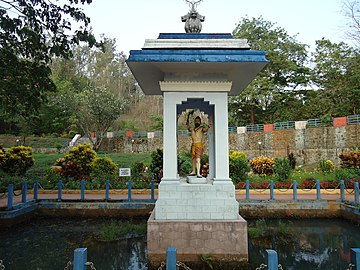
Balarama is a Hindu god. The elder brother of Vāsudeva-Krishna he is described in the Bhagavata Purana as the highest form of divinity that expanded into Vishnu and creation. He is particularly significant in the Jagannath tradition, as one of the triad deities. He is also known as Haladhara, Halayudha, Baladeva, Balabhadra, and Sankarshana.
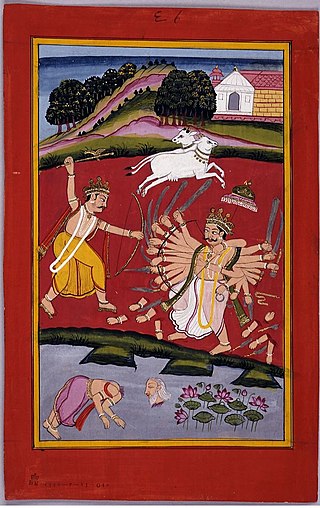
Jamadagni is a sage in Hindu literature. He is regarded in Hindu tradition to be one of the Saptarishi in the 7th, and the current age of Manvantara.

Kartavirya Arjuna was a king of an ancient Haihayas kingdom with capital at Mahishmati which is on the banks of Narmada River in the current state of Madhya Pradesh. Kartavirya was son of Kritavirya, king of the Haihayas. According to the Puranas, Haihaya was the grandson of Sahasrajit, son of Yadu. This is his patronymic, by which he is best known; he is also referred to simply as Arjuna. He is described as having a thousand hands and a great devotee of god Dattatreya.

Kamadhenu, also known as Surabhi, is a divine bovine-goddess described in Hinduism as the mother of all cows. She is a miraculous cow of plenty who provides her owner whatever they desire and is often portrayed as the mother of other cattle. In iconography, she is generally depicted as a white cow with a female head and breasts, the wings of a bird, and the tail of a peafowl or as a white cow containing various deities within her body. Kamadhenu is not worshipped independently as a goddess. Rather, she is honored by the Hindu veneration of cows, who are regarded as her earthly embodiments.
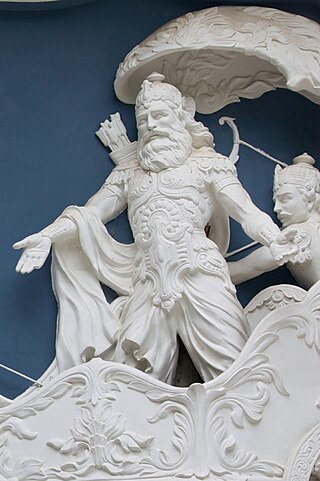
Bhishma, also known as Pitamaha, Gangaputra, and Devavrata, is a major character of the epic Mahabharata. He was the supreme commander of the Kaurava forces during the Kurukshetra War of the epic. He was the only character who witnessed the entirety of the events of the Mahabharata, beginning from the reign of his father, King Shantanu of the Kuru kingdom. Bhishma was the stepbrother of Vyasa, the grandfather of both the Pandavas and the Kauravas. He was a prominent statesman of the Kuru Kingdom. He was born as the elder son of the illustrious King Shantanu and goddess Ganga.
Kripa, also known as Kripacharya, is a figure in Hindu History. According to the epic Mahabharata, he was a council member of Kuru Kingdom and a teacher of the Pandava and Kaurava princes.
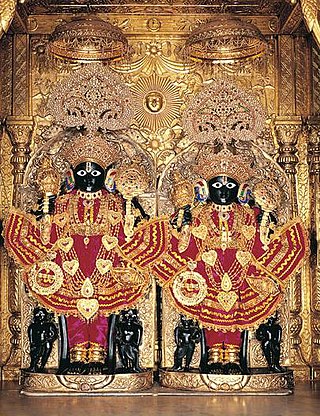
Naranarayana, also rendered Nara-Narayana, is a Hindu duo of sage-brothers. Generally regarded to be the partial-incarnation (aṃśa-avatara) of the preserver deity, Vishnu, on earth, Nara-Narayana are described to be the sons of Dharma and Ahimsa.
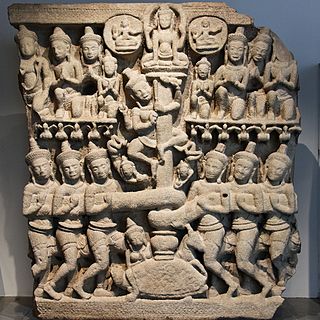
Hindu mythological wars are the wars described in the Hindu texts of ancient India. These wars depicted both mortals of great prowess as well as deities and supernatural beings, often wielding supernatural weapons of great power. Hindu teachings prescribe war as the final option, to be employed only after all peaceful methods are exhausted. Participation in righteous war, or dharmayuddha, was said to be honourable and was a principal duty of the Kshatriya or the warrior varna, and victory in such wars was regarded as a matter of honour.

Renuka, also known as Yellamma, is a Hindu goddess worshipped predominantly in the South Indian states of Karnataka, Tamil Nadu, Telangana, Kerala, Andhra Pradesh and western state of Maharashtra. She is also known as the mother of Parashurama, the sixth avatar of the god Vishnu. She acquired the status of a mother goddess before eventually being associated with the legend of Parashurama.
In the Mahabharata epic, the Heheya Kingdom is one of the kingdoms ruled by Chandravanshi (Yadava) kings in central and western India. It was ruled by Kartavirya Arjuna, who defeated Ravana. Its capital was Mahishmati on the banks of river Narmada in present-day Madhya Pradesh. Talajangha was an allied kingdom to the east of Heheya. They conquered many other kingdoms of India until enmity with the warrior Bhargavas resulted in their demise. Parasurama was the Bhargava leader who ended the kingdom.
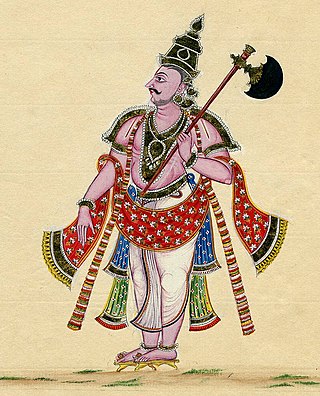
Parashu is the Sanskrit word for a battle-axe, which can be wielded with one or both hands.

Sumatinatha was the fifth Jain Tirthankara of the present age (Avasarpini). Sumatinatha was born to a Kshatriya King Megha (Megharatha) and Queen Mangalavati (Sumangalavati) at Ayodhya in the Ikshvaku dynasty. His Janma Kalyanak (birthday) was the eighth day of the Vaisakha Sudi month of the Jain calendar.
In Hinduism, an astra was a supernatural weapon, presided over by a specific deity and imbued with spiritual and occult powers that caused its effect or impact. Later the word came to denote any weapon which was used by releasing it from one's hand, compared to keeping it one's hand (Shastra). In Ramayana and Mahabharata, Rama had more astras than any other warrior. It is believed that Rama possessed all the astras.

The Dashavatara are the ten primary avatars of Vishnu, a principal Hindu god. Vishnu is said to descend in the form of an avatar to restore cosmic order. The word Dashavatara derives from daśa, meaning "ten", and avatāra, roughly equivalent to "incarnation".

Sharanga also spelt as Saranga, is the celestial bow of the Hindu god Vishnu, primarily associated with his avatar of Rama. In South India, the Sharanga is also simply known as the Kodanda, literally meaning bow. Rama is often praised as Kodandapani, the holder of the Kodanda. The attribute of the bow is also mentioned in the Vishnu Sahasranama.

Mahendragiri, is a mountain in Rayagada block of the district of Gajapati, Odisha, India. It is situated amongst the Eastern Ghats at an elevation of 1,501 metres (4,925 ft).
Amba is a character in the Hindu epic Mahabharata. She is the eldest and most beautiful daughter of Kashya, the King of Kashi, and the sister of Ambika and Ambalika.
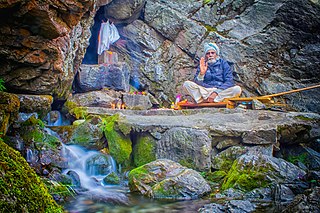
Parshuram Kund is a Hindu pilgrimage sites situated on the Brahmaputra plateau in the lower reaches of the Lohit River and 21 km north of Tezu in Lohit district of Arunachal Pradesh, India. Dedicated to the deity Parashurama, the popular site attracts pilgrims from Nepal, from across India,including the nearby states of Manipur and Assam. Over 70,000 devotees and sadhus take a holy dip in its water each year on the occasion of Makar Sankranti, in the month of January.

The Puranic chronology is a timeline of Hindu mythology based on the Mahabharata, the Ramayana, and the Puranas. The central dates here are the Kurukshetra War and the Lanka War with the start of the start and end of the Kali Yuga and the other yugas and all the other events in Hindu mythology. The Puranic chronology is referred to by proponents of Indigenous Aryans to propose an earlier dating of the Vedic period, and the spread of Indo-European languages out of India, arguing that "the Indian civilization must be viewed as an unbroken tradition that goes back to the earliest period of the Sindhu-Sarasvati Valley traditions ."
Vyasaa.k.a.Veda Vyāsa is the title given to the Rishi (sage) who comes at the end of every Dvapara Yuga to divide and compile the one Veda into four and compile the Puranas and Mahabharata for the benefit of mankind in the degraded age that follows, Kali Yuga. Vyasa is a central and revered figure in most Hindu traditions. In the 28th mahayuga (current), Krishna Dvaipāyana Vyasa was Vyasa, whose name refers to his complexion and birthplace, and who is believed to be a partial incarnation of Vishnu that occurs once in every kalpa. In the upcoming 29th mahayuga, Guru Drona's son Rishi Aswatthama will be born as the next Vyasa. In the previous 27th mahayuga, Veda Vyasa's father was Vyasa.
